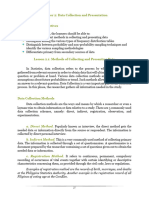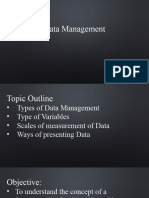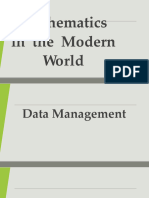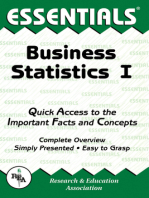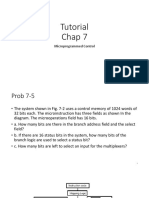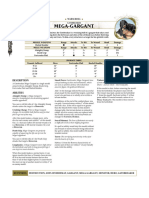Data Management Notes
Uploaded by
tanlecaballaData Management Notes
Uploaded by
tanlecaballa1
Cebu Institute of Technology – University to characterize data. Nominal data deals with
N. Bacalso Ave. Cebu City names, categories, or labels. Data at the
nominal level is qualitative. Colors of eyes, yes
Math 031 – Mathematics in the Modern World or no responses to a survey, and favorite
Mathematics as a Tool breakfast cereal all deal with the nominal level
Data Management (Lesson 1) of measurement.
Mathematics is a powerful tool for global Ordinal level of measurement ranks
understanding and communication. Using it, qualitative data. Winners in a pageant and the
students can make sense of the world and academic rank of teachers are examples of
solve complex and real problems. Rethinking ordinal data. Interval level of measurement
math in a global context offers students a twist deals with data that can be ordered, and in
on the typical content that makes the math which differences between the data does make
itself more applicable and meaningful for sense. Data at this level does not have a
students. For students to function in a global starting point. The Fahrenheit and Celsius
context, math content needs to help them get scales of temperatures are both examples of
to global competence, which is understanding data at the interval level of measurement.
different perspectives and world conditions, The fourth and highest level of measurement
recognizing that issues are interconnected is the ratio level. Data at the ratio level
across the globe, as well as communicating possess all of the features of the interval level,
and acting in appropriate ways. In math, this in addition to a zero value. Examples are
means reconsidering the typical content in a weight, the time to answer a quiz and the
typical way and showing students how the number of absences of students in a class.
world consists of situations, events and
phenomena that can be sorted out using the Presenting Data Using Graphs and Charts,
right math tools. In this learning material, you and Interpreting Organized Data
will find out how mathematics is applied as a
powerful tool in our nature. After the data have been collected and
processed, data need to be organized to
Data produce meaningful information. There are
three methods in presenting information from
Data is everywhere. It is observable or the data set.
measurable. With the advancement of
technology every day, data can be accessed 1. Textual or paragraph or narrative form
anywhere and by anyone. When data is
correct, valid analysis and interpretation can be This describes the data by enumerating
generated to produce valuable information. some of the important feature of the data set
like giving the highest, lowest or the average
Gathering and Organizing Data values. In case there are only few
observations, say less than ten observations,
Data are the quantities Data are the the values could be enumerated if there is a
quantities (numbers) or qualities (attributes) need to do so. Data could also be presented
measured or observed that are to be collected using tables.
and analyzed (Asaad, 2004). There are two
types of data: the qualitative and quantitative 2. Tabular method of presentation
data. Qualitative data deals with categories or
attributes. Examples are color of eyes, ethnicity This is applicable for large data sets. A
and brand of ice cream. Quantitative data are frequency is the number of times a value of
numerical data. Quantitative data can be the data occurs. A frequency distribution is
discrete or continuous. Discrete data is the organization of raw data in table form,
obtained through counting. Continuous data using classes and frequencies.
is obtained by measuring. The number of A relative frequency is the ratio
households in a particular community is an (fraction or proportion) of the number of times a
example of discrete data while family income value of the data occurs in the set of all
and weight of an individual are some of the outcomes to the total number of outcomes. To
examples of continuous data. find the relative frequencies, divide each
frequency by the total number of students in
Another way is to classify data into four the sample. Relative frequencies can be
levels of measurement such as nominal, written as fractions, percent, or decimals.
ordinal, interval and ratio. The nominal level Cumulative relative frequency is the
of measurement is the lowest of the four ways accumulation of the previous relative
2
frequencies. To find the cumulative relative Task 4
frequencies, add all the previous relative
frequencies to the relative frequency for the In a ½ sheet of yellow pad paper, answer the
current row. (examples will be discussed following, and upload a picture of your answers in
our teams, then submit a copy during our face-to-
during our face-to-face meeting)
face meeting.
3. Graphical Presentation I - For each of these variables, identify whether the
variable is qualitative or quantitative, and if
The graphical presentation on the other quantitative, state whether it is discrete or
hand, is a visual presentation of the data. A continuous.
graph is a tool that helps you learn about the
shape or distribution of a sample. The graph 1. Number of family members in a particular
can be a more effective way of presenting data household
than a mass of numbers because we can see 2. Ownership of a cell phone among family
where data clusters and where there are only a members
3. Length (in minutes) of a longest call made
few data values. Graphs are commonly used in
per month
oral presentation. There are several forms of 4. Amount spent on food in a day
graphs to use like the pie chart, pictograph, bar 5. Occupation of household head
graph, line graph, histogram, frequency 6. Population in Cebu City
polygon and box-plot. 7. Weight of new born babies
8. Number of school’s drop out
Each of the following will be discussed on our 9. Speed of a travelling car
face-to-face meeting. 10. Names of fruits
A. Histogram II - Identify the level of measurement for each of the
B. Frequency Polygon following variable
C. Box Plot
1. Highest education attainment
D. Pareto Chart 2. Hair color
E. Bar Graphs 3. Body Temperature
F. Time Series Graphs 4. Civil Status
G. Pie Charts 5. Total household expenditures in Pesos
6. Ranking of winners in beauty contest
Measures of Central Tendency 7. Gender
8. Scores in a Mathematics test
Any measure indicating the center of a 9. Names of schools
set of data arranged in an array is known as 10. Product names in supermarkets
Measure of Central Tendency. Measure of
III - Solve each item correctly by providing the
Central Tendency provides a very convenient
necessary solutions for what is required.
method of describing a set of scores with a
single value that is used to describe the 1. The data represent the number of days off
“center” of the data. The most commonly used per year for a sample of individuals selected
measures of Central tendency are the mean, from nine different countries. Find the mean.
median and mode.
20, 26, 40, 36, 23, 42, 35, 24, 30
2. The number of rooms in the seven hotels in
Cebu City are 713, 300, 618, 595, 311, 401,
and 292. Find the median.
3. The number of typhoons that have occurred
in the Philippines over a 6-year period
follows. Find the median.
684, 764, 656, 702, 856, 1303
4. Find the mode of the following values:
4, 5, 8, 8, 9, 12, 12, 19, 20
examples will be discussed on our face-to-face 5. Find the mode for the number of employees
meeting. in 10 selected barangays in Cebu City.
110, 731, 1031, 84, 20, 118, 1162, 1977,
103, 752
You might also like
- Data Gathering, Organization, Presentation and InterpretationNo ratings yetData Gathering, Organization, Presentation and Interpretation10 pages
- Signed Learning Material No. 4A Data ManagementNo ratings yetSigned Learning Material No. 4A Data Management14 pages
- Section 2 Mathematics As A Tool Gecmat Chmsu - Cas Mathematics DepartmentNo ratings yetSection 2 Mathematics As A Tool Gecmat Chmsu - Cas Mathematics Department42 pages
- Signed Learning Material No. 4A Data ManagementNo ratings yetSigned Learning Material No. 4A Data Management14 pages
- Data Types: and Its Representation Session - 2 & 3No ratings yetData Types: and Its Representation Session - 2 & 333 pages
- Final Educ 107 Unit 4 ANALYSIS AND INTERPRETATION OF ASSESSMENT RESULTSNo ratings yetFinal Educ 107 Unit 4 ANALYSIS AND INTERPRETATION OF ASSESSMENT RESULTS32 pages
- MET 1 - LESSON 1 Tabular and Graphical Presentation of DataNo ratings yetMET 1 - LESSON 1 Tabular and Graphical Presentation of Data11 pages
- Q4_W1-2_M1-2_Basic-Statistics_SSPElectivesNo ratings yetQ4_W1-2_M1-2_Basic-Statistics_SSPElectives27 pages
- BSIT 1ASigned Learning Material No. 4A Data Management AnswerNo ratings yetBSIT 1ASigned Learning Material No. 4A Data Management Answer16 pages
- Mathematics in The Modern World Statistics: Data Gathering and Organizing DataNo ratings yetMathematics in The Modern World Statistics: Data Gathering and Organizing Data12 pages
- Data Processing and Presentation: Joycee D. LoquiteNo ratings yetData Processing and Presentation: Joycee D. Loquite40 pages
- Lesson 5 - Quantitative Analysis and Interpretation of DataNo ratings yetLesson 5 - Quantitative Analysis and Interpretation of Data78 pages
- Introduction To Business Statistics Through R Software: SoftwareFrom EverandIntroduction To Business Statistics Through R Software: SoftwareNo ratings yet
- Taxation: RC NRC RA Nraeb Nraneb SA On Taxable Income On Passive IncomeNo ratings yetTaxation: RC NRC RA Nraeb Nraneb SA On Taxable Income On Passive Income1 page
- Women in Antiquity New Assessments 1st Edition Richard Hawley pdf download100% (2)Women in Antiquity New Assessments 1st Edition Richard Hawley pdf download47 pages
- Computer System Architecture Third Edition Tutorial - Chap - 07No ratings yetComputer System Architecture Third Edition Tutorial - Chap - 0725 pages
- Keane, W. Rotting Bodies - The Clash of Stances Toward Materiality and Its Ethical Affordances PDFNo ratings yetKeane, W. Rotting Bodies - The Clash of Stances Toward Materiality and Its Ethical Affordances PDF10 pages
- Once A Hare Was Roaming Near A Lake in A ForestNo ratings yetOnce A Hare Was Roaming Near A Lake in A Forest15 pages



















